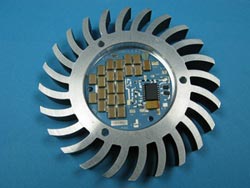Ceramic Transformer Integrates Power Supply Unit

<br>
The new development allows power supply transformers to be reduced to one fifth of their current size so that the normally separate switched-mode power supply units of light-emitting diodes can be integrated into the module's heat sink.
The new technology was developed in cooperation with industrial and research partners who worked together on a joint project for the activation of LEDs by means of LTCC-ferrite modules (ALFerMo).
Components for the control and automation of industrial equipment, building technology, traffic systems, and light-emitting diodes (LEDs) require driver circuits so that they can be activated and supplied with electricity. In many cases, the size of these modules makes it impossible for the systems to have a light and simple structure. If the circuits could be made smaller, they could be embedded in the device. However, transformers pose an obstacle to miniaturization due to their magnetic ferrite core and metallic windings. As a result, transformer size is frequently the factor that determines a module's size.
Using a very bright arrangement of 16 Osram OSLON light-emitting diodes as an example, the ALFerMo consortium has demonstrated how a switched-mode power supply unit can be installed in cavities in the heat sink. Experts at Siemens' global Corporate Technology unit used two techniques to miniaturize the transformer. First, they quadrupled the switching frequency, because the higher the switching frequency, the smaller the transformer can be.
The researchers also developed a layered system of magnetic ceramic films. This allows the ferrite core and the windings to be easily incorporated into a ceramic circuit board. This enabled the transformer to be reduced to one fifth of its original size so that the driver circuit could be installed into an LED heat sink that is ten centimeters wide and five centimeters high. As a result, the LED module no longer requires a separate power supply unit even though it is still as bright as before.
The ALFerMo project expanded the range of possibilities for integrating circuit boards into the compact, modular power electronics assemblies of the future. Smart control systems of this type will make buildings, energy plants, and manufacturing facilities more competitive.
The researchers are now investigating the possibility of applying this technique in the most widespread types of epoxy circuit boards as well as in non-lighting systems. The ALFerMo project is part of the German Research Ministry's Power Electronics for Energy Efficiency Enhancement (LES) program. As part of its high-technology strategy, the German government provided the project with funding amounting to €2.65 million until the end of May 2013.
Media Contact
More Information:
http://www.siemens.com/innovationnewsAll latest news from the category: Power and Electrical Engineering
This topic covers issues related to energy generation, conversion, transportation and consumption and how the industry is addressing the challenge of energy efficiency in general.
innovations-report provides in-depth and informative reports and articles on subjects ranging from wind energy, fuel cell technology, solar energy, geothermal energy, petroleum, gas, nuclear engineering, alternative energy and energy efficiency to fusion, hydrogen and superconductor technologies.
Newest articles

Properties of new materials for microchips
… can now be measured well. Reseachers of Delft University of Technology demonstrated measuring performance properties of ultrathin silicon membranes. Making ever smaller and more powerful chips requires new ultrathin…

Floating solar’s potential
… to support sustainable development by addressing climate, water, and energy goals holistically. A new study published this week in Nature Energy raises the potential for floating solar photovoltaics (FPV)…

Skyrmions move at record speeds
… a step towards the computing of the future. An international research team led by scientists from the CNRS1 has discovered that the magnetic nanobubbles2 known as skyrmions can be…





















